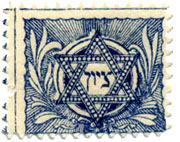Zion
ZionRead in another languageWatch this pageEdit
Ephraim Moses Lilien, Zion, 1903
Ephraim Moses Lilien, Stamp for the Jewish National Fund, Vienna, 1901-2. The symbolic design presents a Star of David containing the word Zion in the Hebrew alphabet.
Mural by Nahum Meltzer, 2006-10.
May our eyes behold your return in mercy to Zion. Design by Lilien to the Fifth Zionist Congress, Basel, December 1901.[1]Zion (Hebrew: צִיּוֹן Ṣîyōn, modern Tsiyyon; also transliterated Sion, Sayon, Syon, Tzion, Tsion) is a placename often used as a synonym for Jerusalem[2][3] as well as for the Land of Israel as a whole. The word is first found in 2 Samuel 5:7which dates from c. 630–540 BCE according to modern scholarship. It originally referred to a specific hill in Jerusalem (Mount Zion), located to the south of Mount Moriah (the Temple Mount). Mount Zion held a Jebusite fortress of the same name that was conquered by David and was re-named the City of David; see Names of Jerusalem. That specific hill ("mount") is one of the many squat hills that form Jerusalem, which also includes Mount Moriah (the Temple Mount), the Mount of Olives, etc. Over many centuries, until as recently as the Ottoman era, the city walls of Jerusalem were rebuilt many times in new locations, so that the particular hill known as Mount Zion is no longer inside the city wall, but its location is now just outside the portion of the Old City wall forming the southern boundary of the Jewish Quarter of the current Old City. Most of the original City of David itself is thus also outside the current city wall.
The term Tzion came to designate the area of Davidic Jerusalem where the fortress stood, and was used as well as synecdoche for the entire city of Jerusalem; and later, when Solomon's Temple was built on the adjacent Mount Moriah (which, as a result, came to be known as the Temple Mount) the meanings of the term Tzion were further extended by synecdoche to the additional meanings of the Temple itself, the hill upon which the Temple stood, the entire city of Jerusalem, the entire biblical Land of Israel, and "the World to Come", the Jewish understanding of the afterlife.
In Kabbalah, the more esoteric reference is made to Tzion being the spiritual point from which reality emerges, located in the Holy of Holies of the First, Second and Third Temple.[4]

内容来自网友分享,若违规或者侵犯您的权益,请联系我们
所有跟帖: ( 主贴楼主有权删除不文明回复,拉黑不受欢迎的用户 )
进入内容页点击屏幕右上分享按钮
楼主前期社区热帖:
- 释迦摩尼是个杀人犯 05/02/21
- 康德的先验论纵览 05/01/21
- 「先天综合判断」 05/01/21
- 古典浪漫主义的语言破解 04/28/21
- 萌芽状态的实用主义国货随想 04/28/21
- 看王羲之子孙十二岁的诗令我哈哈大笑 04/28/21
- 禅宗影响中国古典哲学随想 04/28/21
- 资本意志 04/28/21
- 找出共同点 04/28/21
- 德国尼采的强力意志 04/27/21
- 王阳明心学概括 04/27/21
- 他爸 01/07/21
- test 01/07/21
- 警惕形式逻辑对内容的颠覆£形式逻辑是人类智慧的归纳,是构建各 01/06/21
- 教你学中文 12/16/20
- 花儿与猫咪 11/17/20
- 看图,你告诉我她是不是精神病:还是医生是精神病 11/05/20
- 残疾人是怎么来的呢 11/01/20
- 漫谈总统选举 - 亚里士多德的形而上 10/31/20
- yu di 10/31/20
>>>>查看更多楼主社区动态...




